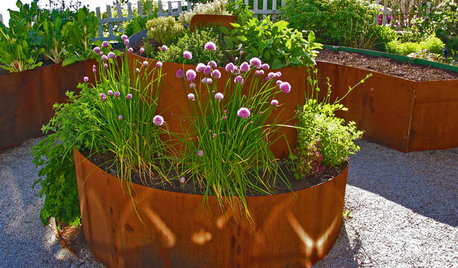New at Veggie gardening - how to aid drainage
Dorothy525
9 years ago
Related Stories

HOUZZ TVHouzz TV: How to Make and Plant a Veggie Box
See how to start edibles from seed, then transfer the seedlings to a box on stilts to make harvesting more fun
Full Story
FARM YOUR YARDHow to Build a Raised Bed for Your Veggies and Plants
Whether you’re farming your parking strip or beautifying your backyard, a planting box you make yourself can come in mighty handy
Full Story
EDIBLE GARDENSHow to Grow Your Own Sweet Summer Crops
This guide will help any gardener get started on growing the freshest warm-season veggies and berries for summer
Full Story
URBAN GARDENSContainers Make Growing Edibles a Cinch
If life hands you a lack of land, grow lemons — with a few basics, you can proudly reap the fruits, veggies and herbs of your labor
Full Story
GARDENING GUIDESGardening Solutions for Heavy Clay Soils
What’s a gardener to do with soil that’s easily compacted and has poor drainage? Find out here
Full Story
GARDENING GUIDESSoutheast Gardener: What to Do in July
Time to claim your prize: a bounty of fruits, veggies and flowers, but don’t forget to keep an eye on weeds, pests and water
Full Story
FARM YOUR YARD10 Easy Edibles to Grow in Containers
These herbs, vegetables and fruits are just as happy in a pot as they are in the ground
Full Story
MOST POPULARHow to Start a Cool-Season Vegetable Garden
Late summer and late winter are good times to plan and plant cool-season crops like salad greens, spinach, beets, carrots and peas
Full Story
EDIBLE GARDENSSummer Crops: How to Grow Tomatoes
Plant tomato seedlings in spring for one of the best tastes of summer, fresh from your backyard
Full Story
FARM YOUR YARDAdvice on Canyon Farming From L.A.'s Vegetable Whisperer
See how a screened garden house and raised beds help an edible garden in a Los Angeles canyon thrive
Full Story





daninthedirt (USDA 9a, HZ9, CentTX, Sunset z30, Cfa)
jean001a
Related Professionals
Prairie Ridge Landscape Architects & Landscape Designers · Brooklyn Park Landscape Contractors · Camp Verde Landscape Contractors · Englewood Landscape Contractors · Fort Hunt Landscape Contractors · Hannibal Landscape Contractors · Lynchburg Landscape Contractors · Rancho Santa Margarita Landscape Contractors · Rockville Landscape Contractors · Palos Hills Landscape Contractors · Goldenrod Landscape Contractors · Cambridge Driveway Installation & Maintenance · Chicago Driveway Installation & Maintenance · San Jose Driveway Installation & Maintenance · Springfield Driveway Installation & Maintenancetheforgottenone1013 (SE MI zone 5b/6a)
Dorothy525Original Author
glib
daninthedirt (USDA 9a, HZ9, CentTX, Sunset z30, Cfa)
grandad_2003